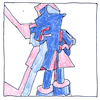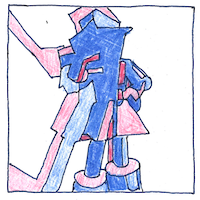Hedy Lamarr,
George Antheil
telecommunication

|
Frequency-hopping
During World War II, Hedy Lamarr wanted to help the war effort and knew from her first husband that radio-controlled torpedoes could be jammed. Lamarr realized that rapidly switching the frequency would defeat any attempt to jam a torpedo. Lamarr appealed to her friend George Antheil for a means to synchronize radio frequencies. Antheil had written Ballet Mécanique for synchronized player pianos and other instruments, so Antheil suggested using miniature player-piano mechanisms for both the transmitter and the torpedo to rapidly switch among 88 frequences, that being the number of keys on a piano.
Prior art, post art
Today frequency hopping is combined with spread spectrum and used in military systems and bluetooth wireless transmissions. In 1908, Jonathan Zenneck mentioned that Telefunken had experimented with it. Leonard Danilewicz reinvented it in 1920. Willem Broertjes patented it in 1932. During WW II, the US Army Signal Corps, with assistance from Alan Turing, invented spread spectrum transmission, but this was a top-secret project. The Lamarr and Antheil patent wasn’t used, but was rediscovered in the 1950s after private companies independently invented frequency hopping.
Cross-disciplinary work
Scientists and artists should work together. (Good ideas aren’t like pigeons in coops.) Artists, creative and impractical, scientists, knowledgeable and analytic, (quarterbacks in tutus, peanuts with wings) can break through learned obsolescence. How many ways can we disarm without violence, cooperate without banning ownership, improve health without increasing population (more choices, birth control, and colorful clothes), increase safety without increasing restrictions, rebuild without destroying our heritages, and listen sympathetically while we disagree (mocking the ritual of us versus them). No discipline should dominate the discussion (no more than pretend insults or military pianos).



Radio jamming became widespread during World War II, became a feature of the Cold War, and is used today by China and Cuba to reduce access to foreign radio stations.
See also in The book of science:
Readings in wikipedia: